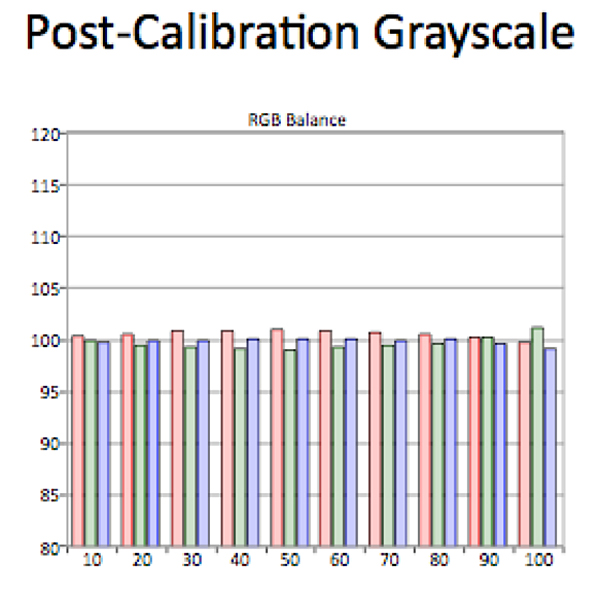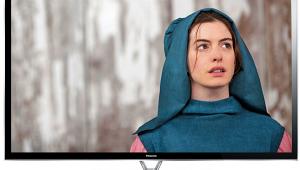Sony XBR-65X900F LCD Ultra HDTV Review Test Bench
The measurements here were made using CalMAN 2018 measurement software from Portrait Displays/SpectraCal, together with Photo Research PR-650 and Klein K-10A color meters and test pattern generators from DVDO (AVLab TPG) and Murideo/AVPro (Fresco Six-G). The measurements were taken in a totally darkened room.
1080P HD/SDR
FULL-ON/FULL-OFF CONTRAST RATIO: Unmeasurable (Local dimming on Medium)


The measurements were taken in the Cinema Home Picture Mode with the Black Level control set to 50, Brightness (backlight) at 10, Contrast at 85, Gamma at -2, X-tended Dynamic Range off, and using an 18% full white window for a measured peak white level of 42.1 foot-lamberts (143 nits). With a full black screen input, the local dimming shut down the screen brightness to total black for an unmeasurable result (it would be misleading to call this infinite contrast, though mathematically it is). With Local Dimming off, the contrast ratio dropped to 2216:1 in these control settings.
In the Expert 1 color temperature mode with the above settings, the pre-calibration grayscale Delta E from 20% to 100% varied from 1.15 at 20% to 2.09 at 70%, an excellent result. Post-calibration, the Delta Es varied from a minimum of 0.3 at 90% to a maximum of 1.30 at 100%. Though the X900F has no CMS (color management system), the post calibration color Delta Es varied from a minimum of 0.91 (red) to a maximum of 1.65 (yellow).
(Delta E is a figure of merit indicating how close the color comes to the standards, either D65 for the white point (gray scale), or the color coordinates for each of the primary and secondary colors that define the color gamut under test. Values below 3—some experts allow for 4—are generally unnoticeable).
With the Gamma control at -2, the Sony’s 1080p/SDR gamma ranged from a high of 2.43 at 90% to 2.37 at20%.
UHD/HDR
FULL-ON/FULL-OFF CONTRAST RATIO: Unmeasurable (Local dimming on Medium)
The After measurements were taken in the Cinema Pro Picture Mode with the Black Level control at 50, the Brightness at Max, the Contrast at 90, the Gamma at 0, and X-tended Dynamic Range on High. With a 10% full white window, the measured peak white level was 297 ft-L (1018 nits). With a full black screen input the local dimming shut down the screen brightness to total black for an unmeasurable result. With Local Dimming off, the contrast dropped to 5211:1—a higher number than for SDR with no local dimming primarily due to HDR’s higher peak white.
The peak white output for HDR varies significantly with how much of the screen is covered with a peak white image—as it does to varying degrees with all displays we’ve tested to date. In the X900F's case, it measured 480 nits at 2%, 857 nits at 5%, 1018 nits at 10%, 908 nits at 25%, and 634 nits at 100%.
Sony has chosen to perform its tone mapping using an EOTF PQ curve (gamma for HDR) that’s lower in brightness over much of its pre-clipping range than the standard HDR EOTF. This delays clipping to a higher level, but also pushes the Delta E values dramatically higher if luminance is included in the Delta E calculation. Without including luminance, however, the post calibration HDR Delta Es were below 2.0 at all levels. The errors were greatest in the middle of the brightness range, and repeated attempts to use the set’s 10-point Advanced Color adjustments failed to cure the situation. Fortunately, it produced no visible issues.
The HDR color checker test investigates a wide variety of possible colors in addition to the usual primaries and secondaries (red, green, blue, cyan, magenta, yellow)—colors such as dark skin, light skin, blue sky, foliage, etc. This test also provided good results without luminance included, with an average Delta E of 1.48.
The Sony covered 69.4% of the B.T. 2020 color gamut (limited mainly by its inability to reach B.T.2020 green, a shortcoming common to virtually all of today’s displays), and 94.4% of P3 (using the 1976 CIE standard for both results). Full B.T. 2020 coverage is currently of little relevance as virtually all current UHD program material is mastered in P3. —TJN




























































